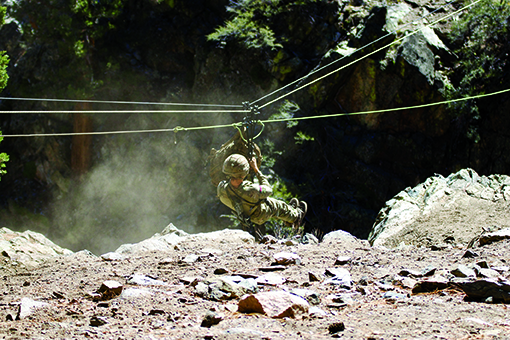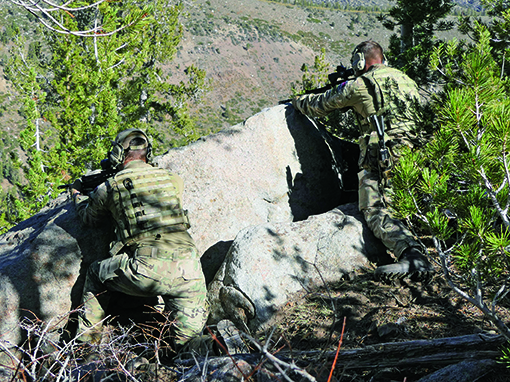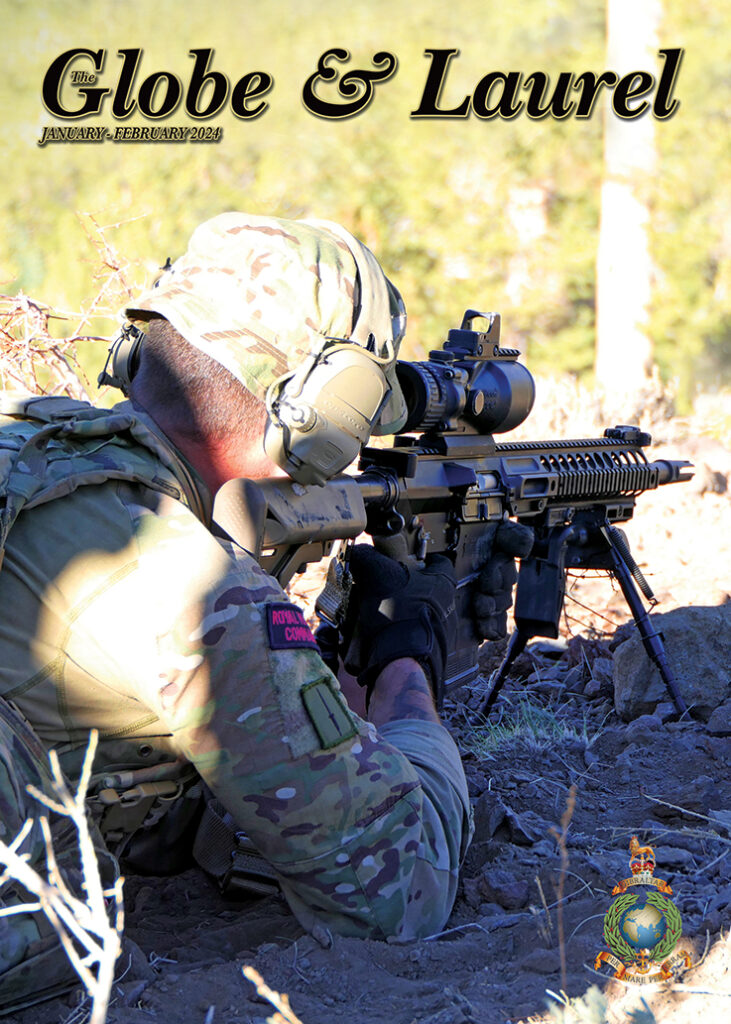Mountain Warfare at Strike Coy Level
The following article is taken from the latest issue of the Globe & Laurel magazine.
Click the button below to discover more.

For those who seek challenge and adventure, there can be little that sparks more excitement than the almost irresistible allure of the mountains. There is arguably no environment that better develops, nor reveals physical fitness, mental toughness and the Commando values. With this in mind, LRG(N) deployed to the USMC’s Mountain Warfare Training Centre (MWTC) deep in the Sierra Nevada mountains of northern California in September 2023. Ex Green Dagger provided a unique opportunity to conduct enhanced mountain warfare training and a force-on-force exercise with, and against, our USMC and French mountain-trained brothers.

‘It’s been more than 20 years since the Commando Force last conducted live operations in the mountains. Operating at heights of over 3000m, the men and women of 45 Cdo Gp RM deployed to Khost Province, Afghanistan, on Op Jacana in March 2002. Outnumbered and in unfamiliar and formidable terrain the Cdo Gp effectively denied Al Qaeda and Taliban fighters safe sanctuary and freedom of movement, forcing them to melt back into the local communities fearing reprise should they stand and fight.’ It is the lessons learned from this, and other mountain warfare case studies, which we must pay particular attention to today. As such, Ex Green Dagger took a three-pronged approach to developing mountain capability at the Strike Coy level: physical fitness, climbing and mountaineering skills and the application of specialist tactics.
Tactical success on Op Jacana was attributed in no small part to the physical fitness and mental robustness of the individual Commandos who made up the fighting Companies deployed on the ground. US Special Forces deployed on Op Anaconda had met with disaster just a few weeks prior as two CH-47s were shot down whilst trying to land troops to gain a foothold in the summit regions of Paktia Province, tragically demonstrating how access to the mountainous theatre must be earned and cannot be bought by technology or equipment.
It takes more however, than physical fitness alone. Mountainous terrain tends to limit mobility and observation, and therefore restricts conventional modern militaries from making full use of sophisticated weapons and equipment. Marshal Tito’s guerrilla operations in the mountains of Yugoslavia between 1943-5 demonstrated how success can be achieved against an opponent who is superior in numbers and weaponry, if the perceived inaccessible terrain can be used as an advantage. Similarly, during the Jebel Akhdar War in Oman between 1957-59, the SAS showcased an incredible ability to navigate the rugged mountainous landscape with advanced climbing and rappelling techniques. Their proficiency in vertical mobility allowed them to utilise routes and avenues of approach that were otherwise discounted by their insurgent opponents, achieving surprise on multiple levels.

It is important to recognise that mountainous terrain is divided doctrinally into three levels (see Image below left). Level One exists at the bottom of valleys, consists of MSRs and population centres and is typically accessible by vehicles. Level Two is the high ground that overlooks these valleys. Level Three is the dominant terrain and summit regions that overlook the valleys and foothills of Levels One and Two. Tactical dominance has repeatedly been achieved throughout history by eschewing the more conventional ideas of mass, frontage and flanking attacks on Level One in favour of disaggregated and dispersed small team actions to control terrain found in and around Level Three. Mountain operations are therefore normally characterised by a series of separately fought battles for the control of this key terrain. The ongoing Siachen conflict in the Himalayas is an example of this, where Indian and Pakistani commandos exchange blows through the conduct of small unit infiltration, raid and ambush techniques to harass and disrupt targets before disappearing back into the complex terrain from where they had come from. The idea is to deny the adversary control of dominating features and key terrain, without committing the mass and resources required to hold and sustain a defensive position.
As Commandos, we should look to find our purpose in the mountains for two reasons. Firstly, as a theatre it tends to favour small team tactics and light-footprint units of highly skilled, physically fit and courageous individuals. Secondly, and more holistically, the toughness forged in the mountains will bring utility to other theatres. Surely there can be no more fearsome a fighting force than one who is not only fit, tough and skilled enough to overcome any terrain, but is also motivated enough to use that same terrain to achieve a disproportionate tactical advantage.
Read more from the Journal of the Royal Marines
For more information, and to read similar stories, visit:
Globe & Laurel – RMA – The Royal Marines Charity (rma-trmc.org)
